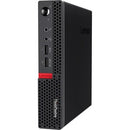Description
The Lenovo ThinkCentre M625q Tiny Thin Client is engineered for modern, security‑driven offices that demand reliable performance in a compact footprint. With its AMD E-Series E2-9000e dual‑core processor and a space‑saving tiny form factor, this device delivers responsive access to virtual desktops, cloud apps, and essential business software without compromising on privacy or manageability. Designed for sectors such as healthcare, finance, and education, the M625q prioritizes privacy, security, and seamless deployment in environments where space and IT budgets are at a premium. Whether you’re standardizing a zero‑client or provisioning a scalable VDI workflow, the M625q provides a dependable foundation for secure remote work, dramatic cost savings, and streamlined IT operations.
- Ultra‑compact, space‑saving design: The Tiny form factor fits neatly beneath monitors, on desks, or in telecommunications enclosures, helping you maximize workstation space without sacrificing performance or reliability.
- Strong security and privacy for sensitive environments: Built to support enterprise‑grade privacy and security needs—ideal for healthcare, financial services, and other industries where data protection is paramount.
- Solid performance for virtual desktops and cloud apps: Powered by the AMD E2‑9000e dual‑core processor, the M625q handles remote desktop sessions, thin client workloads, and day‑to‑day productivity software with dependable responsiveness.
- Centralized management and easy deployment: Designed to simplify IT administration, enabling rapid provisioning, centralized updates, and consistent configurations across large numbers of endpoints.
- Energy efficient and reliable for 24/7 use: Optimized for low power consumption, quiet operation, and long‑term reliability in busy office environments, reducing total cost of ownership over time.
Technical Details of Lenovo ThinkCentre M625q Tiny Thin Client
- Processor: AMD E-Series E2‑9000e Dual‑core (2 Core) 1.50 GHz
- Graphics: AMD Radeon Graphics integrated
- Memory: Not disclosed in available specifications
- Storage: Not disclosed in available specifications
- Operating System: Thin client operating system (specific edition not disclosed)
- Form Factor: Tiny desktop / compact thin client
- Networking: Built‑in Ethernet; wireless connectivity details not disclosed
- Security: Enterprise‑grade privacy and security features designed for sensitive environments
How to install Lenovo ThinkCentre M625q
To deploy the M625q in a modern office or healthcare setting, follow these practical steps to ensure a smooth, scalable rollout. Begin by unboxing the device and verifying all required accessories are present. Connect the thin client to a suitable monitor using the appropriate video interface, then attach a keyboard and mouse to the USB ports. Plug in the power supply and power on the unit to begin the initial setup.
Next, connect the M625q to your network, preferably via a wired Ethernet connection for maximum reliability and security during deployment. If wireless connectivity is supported and required for your environment, configure the wireless settings through the built‑in setup wizard or your centralized management platform.
Once network connectivity is established, access the thin client configuration tool or provisioning console specified by your IT team. This is typically where you configure remote desktop or virtual desktop infrastructure (VDI) connections, specify your RDP, PCoIP, or other protocol settings, and apply your organization’s standard policies and security baselines. Use your centralized management system to push firmware updates, security patches, and software revisions to multiple devices simultaneously, ensuring consistency across the fleet.
During deployment, tailor system settings for compliance and privacy requirements—such as enabling secure boot, enforcing strong authentication, and configuring data handling policies. If necessary, integrate the thin client with your directory services, profile management, and user authentication methods to streamline sign‑in experiences for end users.
Finally, validate user access by launching a test session to verify performance with your typical workloads. Confirm that peripherals, display resolutions, and audio behave as expected, and verify that remote desktops, virtual apps, and local resources (such as USB devices, if permitted) are functioning correctly. Document the configuration so IT staff can replicate and scale the setup across additional units as your organization grows.
Frequently asked questions
Q: What makes the Lenovo ThinkCentre M625q particularly suitable as a thin client?
A: The M625q combines a compact tiny form factor with robust security features and reliable AMD processing capabilities, making it ideal for secure remote access, centralized management, and efficient workload handling in healthcare, education, and enterprise environments.
Q: Which environments benefit most from this device?
A: Environments that prioritize privacy and security, need space‑saving devices, and require scalable remote desktop access—such as clinics, hospitals, banks, classrooms, and call centers—will benefit from the M625q’s combination of security, compactness, and centralized management support.
Q: Can the M625q handle modern virtual desktop workloads?
A: Yes. With an AMD E2‑9000e dual‑core processor and integrated Radeon graphics, the thin client is designed to deliver dependable performance for routine VDI tasks, cloud apps, and essential productivity software, while consuming minimal power.
Q: How is the device managed within a large IT environment?
A: Lenovo’s thin client ecosystem supports centralized management and provisioning, enabling IT to deploy updates, enforce security policies, and standardize configurations across many endpoints from a single console, reducing manual administration and ensuring consistency.
Q: What about security and privacy features?
A: The M625q emphasizes privacy and security through its hardware and software design, with features that support secure boot, policy enforcement, and controlled data handling—critical for healthcare, finance, and other data‑sensitive industries.
Customer reviews
Showing - Of Reviews


